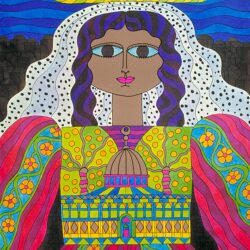Josephus Thimister: The Blood of a Poet

For those who were lucky enough to have known him during their lifetime, Josephus Thimister’s personality was indeed larger-than-life. Born in Maastricht in 1962, he graduated from Antwerp’s Royal Academy of Fine Arts Summa Cum Laude in 1987. Despite not being Belgian himself, Thimister was often associated with the second wave of Belgian designers that captivated the Paris scene during the late 1990s, including Raf Simons, Olivier Theyskens, Veronique Branquinho or Jurgi Persoons. If Thimister’s style was not as extreme or transgressive as some of his peers, he nevertheless had a taste for dramatic gestures and operatic clothes, which gave a sense of grandeur -and nobility- to many of his shows.


Humor and darkness
His standout Autumn-Winter 2010-11 Couture collection - which he decided to present during the Spring Paris Couture calendar - combined military coats and jackets with floor-length evening skirts, innovative ballgowns and exquisite cocktail dresses. Several garments were covered with what looked like blood splatters, referencing the atrocities and bloodshed of WW1. In person, Thimister had a sarcastic sense of humor and could be devastatingly funny, but there clearly was a darkness to his soul.


Inspiration within history
Having worked for prestigious houses in Paris, such as Patou, Charles Jourdan and Balenciaga - where he stayed from 1992 to 1997 - Thimister had a strong, and developed, Couture sensibility, which was enriched by his interest in menswear and utility styles. His passion for workwear was therefore apparent in many of his collections, as well as his love affair with Le Grand Soir, which you will find in several collections he designed under his name, from the ethereal gowns he showcased within his Autumn-Winter 1998-99 Haute Couture collection to the closing look of his Autumn-Winter 2010-11 Haute Couture collection, an imposing and shoulder-baring ballgown embroidered with contrasting gold and silver metallic threads.


If Thimister clearly had romance in mind, he was also interested in the notions of decay and decadence, finding endless sources of inspiration within European history. It was therefore no surprise that military uniforms were a leitmotiv within his Autumn-Winter 2010-11 Haute Couture show, where the designer innovated by showing Couture garments on both men and women. In fact, several pieces were unisex and could have been swapped, something which today has become commonplace in our industry.


Broken elegance
Thimister could also do miracles with knitwear and seemed rather obsessed with the imprint and imperfections of the human hand, as evidenced in a gorgeous sleeveless ribbon effect dress from his Fall-Winter 1998-99 Haute Couture show, which looked like an overblown piece of handmade crochet. Thimister definitely knew how to play with textures and often went for bold and unexpected contrasts.


In fact, American fashion critic Cathy Horyn once described his style as “broken elegance”, which does sum up the essence of what Thimister was after. Not interested in stereotypical beauty, the Dutch designer was looking for a poetic balance between rough and soft, fuzzy and flat, structured and deconstructed, outstanding and utilitarian. He understood opulence, too, but in a contemporary way, which went beyond the pared-down logics of 90s minimalism.


Underrated talent
Today, Josephus Thimister’s clothes have retained some of their roughness and power, as well as their sense of mystery. They are contemporary because they offer a study in contrasts that reflects the nature of our world. The pieces that MoMu owns now - a donation of silhouettes from his previous collections - seem fresh, innovative, unusual and timeless. A men’s silhouette from his Autumn-Winter 2010-11 collection is now on view in the new rotation of MoMu’s Collection presentation, underlining the talent of a designer who is often underlooked or underrated within the history of fashion.
You can discover Thimister's work in MoMu's Collection presentation. More info





